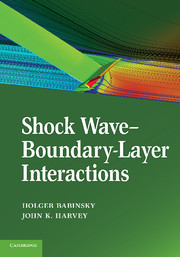Book contents
- Frontmatter
- Brief Contents
- Contents
- Contributors
- 1 Introduction
- 2 Physical Introduction
- 3 Transonic Shock Wave???Boundary-Layer Interactions
- 4 Ideal-Gas Shock Wave???Turbulent Boundary-Layer Interactions (STBLIs) in Supersonic Flows and Their Modeling: Two-Dimensional Interactions
- 5 Ideal-Gas Shock Wave???Turbulent Boundary-Layer Interactions in Supersonic Flows and Their Modeling: Three-Dimensional Interactions
- 6 Experimental Studies of Shock Wave???Boundary-Layer Interactions in Hypersonic Flows
- 7 Numerical Simulation of Hypersonic Shock Wave???Boundary-Layer Interactions
- 8 Shock Wave???Boundary-Layer Interactions Occurring in Hypersonic Flows in the Upper Atmosphere
- 9 Shock-Wave Unsteadiness in Turbulent Shock Boundary-Layer Interactions
- 10 Analytical Treatment of Shock Wave???Boundary-Layer Interactions
- Index
- References
4 - Ideal-Gas Shock Wave???Turbulent Boundary-Layer Interactions (STBLIs) in Supersonic Flows and Their Modeling: Two-Dimensional Interactions
Published online by Cambridge University Press: 05 June 2012
- Frontmatter
- Brief Contents
- Contents
- Contributors
- 1 Introduction
- 2 Physical Introduction
- 3 Transonic Shock Wave???Boundary-Layer Interactions
- 4 Ideal-Gas Shock Wave???Turbulent Boundary-Layer Interactions (STBLIs) in Supersonic Flows and Their Modeling: Two-Dimensional Interactions
- 5 Ideal-Gas Shock Wave???Turbulent Boundary-Layer Interactions in Supersonic Flows and Their Modeling: Three-Dimensional Interactions
- 6 Experimental Studies of Shock Wave???Boundary-Layer Interactions in Hypersonic Flows
- 7 Numerical Simulation of Hypersonic Shock Wave???Boundary-Layer Interactions
- 8 Shock Wave???Boundary-Layer Interactions Occurring in Hypersonic Flows in the Upper Atmosphere
- 9 Shock-Wave Unsteadiness in Turbulent Shock Boundary-Layer Interactions
- 10 Analytical Treatment of Shock Wave???Boundary-Layer Interactions
- Index
- References
Summary
Introduction
Effective design of modern supersonic and hypersonic vehicles requires an understanding of the physical flowfield structure of shock wave–boundary layer interactions (SBLIs) and efficient simulation methods for their description (Fig. 4.1). The focus of this chapter is two-dimensional supersonic shock wave–turbulent boundary layer interactions (STBLIs); however, even in nominally two-dimensional/axisymmetric flows, the mean flow statistics may be three-dimensional. The discussion is restricted to ideal, homogeneous gas flow wherein the upstream free-stream conditions are mainly supersonic (1.1 ≤ M∞ ≤ 5.5). Computational fluid dynamics (CFD) simulations of two-dimensional STBLIs are evaluated in parallel with considerations of flowfield structures and physical properties obtained from both experimental data and numerical calculations.
Problems and Directions of Current Research
The main challenges for modeling of and understanding the wide variety of two- and three-dimensional STBLIs include the complexity of the flow topologies and physical properties and the lack of a rigorous theory describing turbulent flows. These problems have been widely discussed during various stages of STBLI research since the 1940s. In accordance with authoritative surveys [1, 2, 3, 4, 5, 6, 7] and monographs [8, 9, 10, 11], progress in understanding STBLIs can be achieved only on the basis of close symbiosis between CFD and detailed physical experiments that focus on simplified configurations (see Fig. 4.1) and that use recent advances in experimental diagnostics (e.g., planar laser scattering [PLS]; particle image velocimetry [PIV]); and turbulence modeling, including Reynolds-averaged Navier-Stokes [RANS], large eddy simulation [LES], and direct numerical simulation [DNS]).
- Type
- Chapter
- Information
- Shock Wave-Boundary-Layer Interactions , pp. 137 - 201Publisher: Cambridge University PressPrint publication year: 2011
References
- 4
- Cited by

